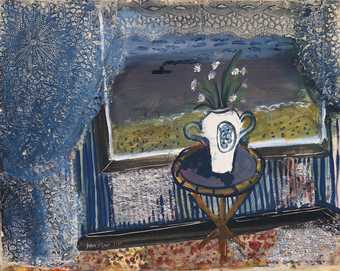
John Piper
Beach with Starfish (c.1933–4)
Tate
In my grandfather’s studio at Fawley Bottom Farmhouse, Oxfordshire, there was a drawer of newspaper cuttings, wrappers, labels, different types of card and paper (corrugated, perforated, stencilled or ornamental – some with metallic or textured effects) and paper doilies of various shapes, sizes and colours. There was a paper bag from a picnic in Brittany and the label from a can of sheep dip, which he found while sketching in the field.
I remember the temporary homemade water tanks at the farmhouse – shallow, wooden planks lined with plastic sheeting – and the smaller, yet megalithic, washstand-style slate sinks in the top studio cottage at Garn Fawr in Pembrokeshire. My grandfather would use these tanks to produce psychedelic marbled effects, floating sheets of art paper in a mixture of ink, oils and white spirit, hanging them to dry on a line with clothes pegs. These background effects often mimicked foliage, lichen-patterned walls, sky or cliffs when cut into fragments and painted on. As children we enjoyed cutting and gluing these materials to make cards, or just for fun, pre-empting my teen obsession with the 1970s punk art period and things like the Sex Pistols’ album covers with their ransom-note-style, cut-out lettering.
JP’s collage work is not the same as pop art collage, but there is something anarchic about it. He was part of (yet also resisted) the abstract movement, led by Picasso, Braque and Léger and followed to varying degrees by many English painters: Paul Nash, Ben Nicholson, Ceri Richards and Henry Moore. These artists all used still lifes and found objects, juxtaposing them in a kind of surreal way. But I think JP was too faithful to his subject matter to use these elements out of context with what he actually saw. His collages articulated what he had been observing, sketching and photographing in the natural landscape and the built environment: a coastline in North Wales or derelict mine workings; a lighthouse on Portland Bill; Knowlton Church, Dorset; the view from Garn Fawr; celtic designs, sketched from tombstones or churches then rendered as marbled paper on a coloured background. These drawings and photographs were used to create motifs to make prints, designs for stage sets, stained glass, fabrics or ceramics – or, indeed, finished collage work.

John Piper, View from a Window c.1933, gouache and printed collage, 35.6 x 46.4 cm
© The Piper Estate, courtesy Offer Waterman Gallery
As the titles of his pieces suggest – Beach with Starfish c.1933–4, View from a Window c.1933 – they are not so much about the conceptual juxtaposition of fragments used in the designs as they are about the places or objects that inspired them. Because of this, the subjects of his collages are always instantly recognisable to me.
John Piper, curated by Darren Pih with Tamar Hemmes, supported by the John Piper Exhibition Supporters Group, Tate Liverpool Members and Liverpool City Council, Tate Liverpool, 17 November – 18 March 2018. The exhibition travels to Mead Gallery, University of Warwick, from 1 May to 24 June 2018
Luke Piper is a landscape painter and producer / creative director for outdoor events.
